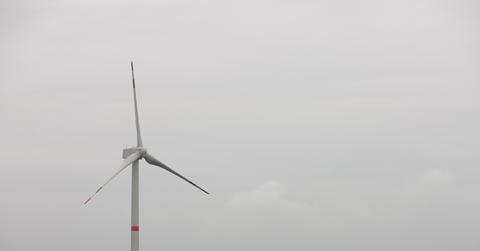Offshore Wind Farms Continue To Expand In United States
Block Island, located to the south of Rhode Island, is now exclusively powered by an offshore wind farm. After skepticism in the past, the surge to build them along the Northeastern coast of the US could finally rival those in other countries.
Updated May 24 2019, 7:09 a.m. ET
Offshore wind farms are gaining some traction in the United States. Rhode Island became the first state to be tested with this alternative energy source and it now exclusively powers its roughly 2,000 electric customers on Block Island. The number of turbines in the Northeast will only grow from here.
The first offshore wind farm designated for the US started up last October. After weeks of testing, they officially started pumping electricity to the mainland of Rhode Island. Steph Machado of WPRI reports that as of Monday, Block Island moved their source of energy to the wind turbines from diesel fuel, and the cut will save roughly one million gallons of that fuel per year.
"About one-sixth of the power generated by the turbines is powering Block Island, according to Wright, and the rest goes to the mainland. It powers the equivalent of 17,000 homes, but still represents only 1.5% of the total power usage in Rhode Island."
That number will certainly grow in the coming years. Block Island customers will be saving roughly $30 per month on the switch alone, which includes the taxes that have been added for the residents to pay for the turbines. However, that will be it as far as any additional construction off the coast of Block Island, given that the wind farm is too close to the mainland.
It’s a different story off the coast of Long Island, as there are ongoing plans to construct close to 200 of the turbines at a wind farm that can fuel the entire state of Rhode Island.
America is joining in late on the offshore wind farm revolution. The United Kingdom houses five of the top eight in the world that are currently operational, with the London Array being the biggest at churning 630 megawatts of energy after opening in 2013. There are 175 wind turbines at this location. There were talks about adding a “phase two,” or expanding the farm, but it was trashed due to the potential major impact it could have had on red-throated diver bird species.
Without expansion, that farm will soon be thwarted by the Hornsea Project Two, which is estimated to produce 1.8 gigawatts of energy through 300 turbines. Over 1.6 million homes -- not people -- would be powered. Another potential farm, Hornsea Project Three, could top that at 2.4 gigawatts, but planning is still ongoing for that project.
The reason for the long delay in the United States was due to skepticism. Justin Gillis of the New York Times explains that people didn’t believe these farms would be able to bring enough energy to meet demand.
"The idea of building turbines offshore, where strong, steady wind could, in theory, generate large amounts of power, has long been seen as a vital step toward a future based on renewable energy. Yet even as European nations installed thousands of the machines, American proposals ran into roadblocks, including high costs, murky rules about the use of the seafloor, and stiff opposition from people who did not want their ocean views marred by machinery."
Times have changed significantly. New York is hoping to reach that same 2.4 gigawatt capacity Hornsea Project Three aims for by 2030. It will begin in the aforementioned Long Island area, dubbed the “South Fork Wind Farm.” It has been greenlit and will begin in production in 2019 to set up 15 turbines and nearly 100 megawatts of power. One gigawatt is likely the maximum for this area.
